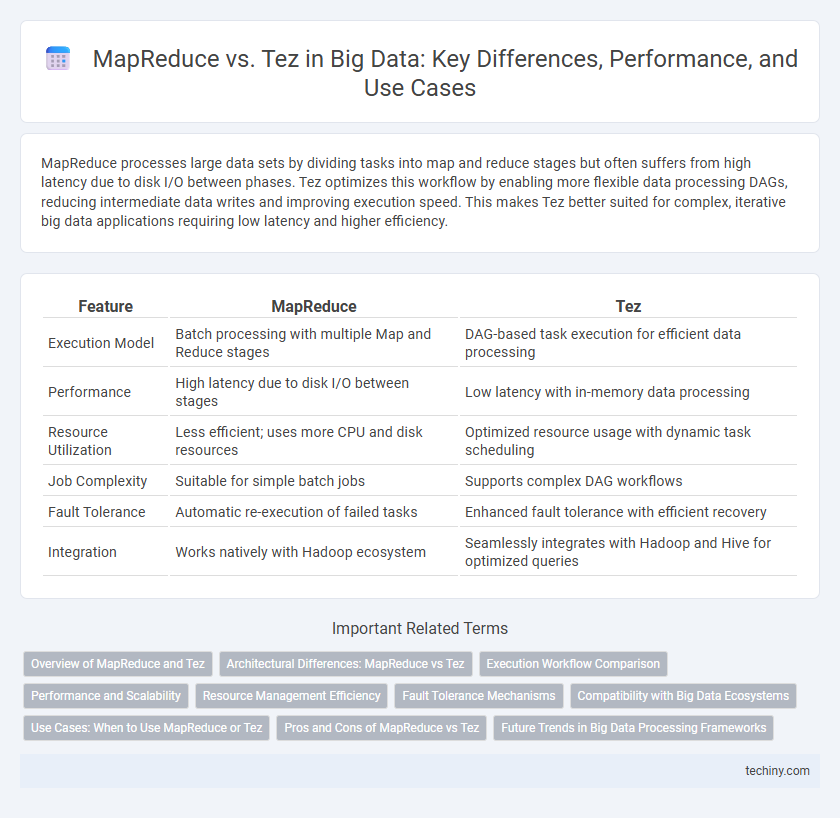MapReduce processes large data sets by dividing tasks into map and reduce stages but often suffers from high latency due to disk I/O between phases. Tez optimizes this workflow by enabling more flexible data processing DAGs, reducing intermediate data writes and improving execution speed. This makes Tez better suited for complex, iterative big data applications requiring low latency and higher efficiency.
Table of Comparison
| Feature | MapReduce | Tez |
|---|---|---|
| Execution Model | Batch processing with multiple Map and Reduce stages | DAG-based task execution for efficient data processing |
| Performance | High latency due to disk I/O between stages | Low latency with in-memory data processing |
| Resource Utilization | Less efficient; uses more CPU and disk resources | Optimized resource usage with dynamic task scheduling |
| Job Complexity | Suitable for simple batch jobs | Supports complex DAG workflows |
| Fault Tolerance | Automatic re-execution of failed tasks | Enhanced fault tolerance with efficient recovery |
| Integration | Works natively with Hadoop ecosystem | Seamlessly integrates with Hadoop and Hive for optimized queries |
Overview of MapReduce and Tez
MapReduce is a foundational big data processing framework that divides tasks into map and reduce phases to process large datasets in parallel across clusters. Tez, an advanced execution engine built on top of YARN, optimizes complex directed acyclic graph (DAG) workflows by reducing I/O overhead and enabling more flexible data processing pipelines. Tez improves performance and resource utilization compared to traditional MapReduce by supporting iterative processing and dynamic task execution.
Architectural Differences: MapReduce vs Tez
MapReduce follows a rigid two-stage processing architecture consisting of a map phase followed by a reduce phase, which often leads to multiple disk read/write cycles and increased latency. Tez utilizes a flexible directed acyclic graph (DAG) structure that enables complex data processing workflows to execute as a single continuous job, minimizing intermediate I/O operations. The architectural flexibility of Tez results in improved resource utilization and lower execution time compared to the traditional MapReduce model.
Execution Workflow Comparison
MapReduce processes data in two rigid phases, mapping and reducing, relying heavily on disk I/O between each phase, which can cause latency in execution. Tez offers a more flexible directed acyclic graph (DAG) execution engine that enables complex workflows with multiple stages and fewer intermediate disk writes, significantly improving performance. By optimizing task scheduling and resource allocation, Tez reduces execution time compared to the traditional MapReduce framework.
Performance and Scalability
MapReduce processes large data sets by splitting tasks into map and reduce phases, offering robust scalability but often suffering from high latency due to its disk-based intermediate data storage. Tez improves performance by enabling complex directed acyclic graph (DAG) workflows and in-memory data processing, which reduces I/O overhead and lowers execution time. Both frameworks scale efficiently on distributed clusters, but Tez provides superior responsiveness and throughput for iterative and multi-stage data processing workloads.
Resource Management Efficiency
MapReduce processes large datasets through sequential map and reduce phases, often leading to higher resource consumption and increased job latency. Tez optimizes resource management by enabling directed acyclic graph (DAG) execution, which allows multiple processing stages to run within a single job, reducing overhead and improving CPU and memory utilization. This efficiency in task scheduling and resource allocation makes Tez more suitable for complex, iterative big data workflows compared to traditional MapReduce.
Fault Tolerance Mechanisms
MapReduce employs a checkpoint-based fault tolerance mechanism by dividing tasks into map and reduce phases, where intermediate data is written to disk, enabling task retries upon failure. Tez enhances fault tolerance by creating a directed acyclic graph (DAG) of tasks with fine-grained task recovery and speculative execution, minimizing recomputation overhead. The DAG structure in Tez allows for dynamic task re-execution and data lineage tracking, improving fault detection and recovery efficiency compared to the rigid MapReduce model.
Compatibility with Big Data Ecosystems
MapReduce demonstrates broad compatibility across many Big Data ecosystems, supporting diverse storage systems like HDFS, HBase, and Amazon S3. Tez integrates deeply with Apache Hadoop and Apache Hive, providing optimized DAG-based execution for complex data processing workflows within these environments. While MapReduce is well-established, Tez offers enhanced performance and flexibility for ecosystem components that demand low-latency and iterative processing.
Use Cases: When to Use MapReduce or Tez
MapReduce suits batch processing tasks with high latency tolerance, such as log analysis, large-scale ETL jobs, and data archiving in Hadoop ecosystems. Tez optimizes complex, multi-stage workflows like interactive querying, real-time analytics, and iterative machine learning, offering lower latency and enhanced performance over MapReduce. Use MapReduce for straightforward, fault-tolerant batch workloads and Tez when workflow efficiency and speed are critical in big data pipelines.
Pros and Cons of MapReduce vs Tez
MapReduce provides robust fault tolerance and simplicity through its batch processing model but suffers from high latency and inefficiency in iterative tasks due to multiple disk I/O operations. Tez improves performance by enabling complex directed acyclic graph (DAG) workflows with in-memory processing, reducing latency and resource consumption in comparison to MapReduce. However, Tez requires a steeper learning curve and more complex job management, which can increase development overhead for teams unfamiliar with the framework.
Future Trends in Big Data Processing Frameworks
MapReduce, once the cornerstone of big data processing, is gradually being eclipsed by more flexible and efficient frameworks like Apache Tez, which enhances data flow execution through optimized DAG processing and reduced latency. Future trends in big data frameworks emphasize real-time analytics, in-memory processing, and integration with machine learning pipelines to handle growing data volumes and velocity. Apache Tez's ability to seamlessly integrate with Hadoop ecosystem components positions it as a pivotal technology for next-generation, scalable big data applications.
MapReduce vs Tez Infographic

 techiny.com
techiny.com